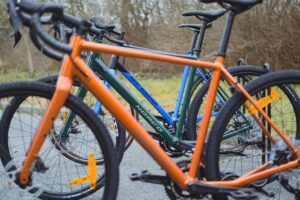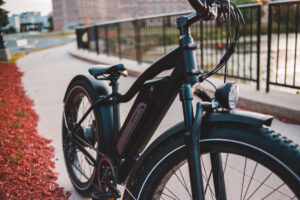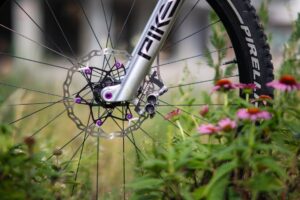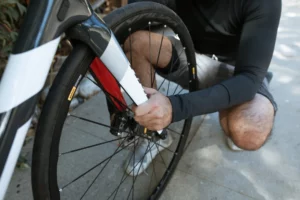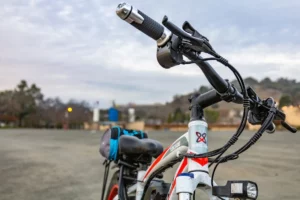Bike handlebars, as a important part of bike parts, play a crucial role in the overall functionality and comfort of your cycling experience. In this comprehensive guide, we will dive into 8 different types of handlebars for bikes available. Whether you’re a road cyclist seeking speed, a mountain biker craving adventure, or a leisure rider looking for comfort, there’s a bike handlebar type designed just for you.
8 Bicycle Handlebar Types
There are 8 commom types of handlebars available for bikes, including:
- Drop Bars: Ideal for road cycling, these bars offer aerodynamic positioning, power transfer, and control.
- Flat Bars: Suitable for mountain biking and leisure rides, they provide an upright riding position for maneuverability.
- Riser Bars: Designed for off-road and trail riding, these bars offer a more comfortable and upright posture.
- Bullhorn Bars: Popular in urban cycling, they have a stylish design and versatile gripping positions.
- Aero Bars: Specifically designed for time trials and triathlons, these bars enhance speed and efficiency with an aerodynamic position.
- Butterfly Bars: Suitable for touring and long-distance rides, they offer multiple hand positions for comfort.
- Moustache Bars: These bars provide versatility with a wide range of hand positions and are suitable for various riding styles.
- Cruiser Bars: Perfect for casual and leisurely rides, they offer a relaxed and comfortable riding position.
Drop Bars

Drop bars are a classic choice for road cycling enthusiasts. With a curved design that promotes an aerodynamic posture, drop bars offer numerous benefits. These include improved power transfer, increased speed, and enhanced control. From traditional drop bars to compact and ergonomic variations, there’s a type of handle bar that suits every rider’s preference.
Flat Bars

Ideal for mountain biking and leisure rides, flat bars offer a more upright riding position, ensuring better control and maneuverability on rough terrains. The simplicity of their design makes them highly versatile and suitable for riders of all skill levels. Explore variations such as riser flat bars or wide flat bars to find your optimal style.
Riser Bars

If off-road and trail riding is your passion, riser bars are the perfect choice. These handlebars feature a higher rise, providing a more upright and comfortable riding posture. Riser bars excel in absorbing shocks and vibrations, ensuring a smooth and enjoyable ride through challenging terrains. Different variations, including pull-back riser bars, allow for further customization to achieve your desired riding position.
Bullhorn Bars

Popular among urban and city cyclists, bullhorn bars offer a sleek and stylish design. With their unique shape resembling bullhorns, these handlebars provide multiple gripping positions, catering to different riding preferences. Whether you prefer a forward position for a more aggressive ride or a relaxed grip for casual cycling, bullhorn bars offer versatility and a modern aesthetic.
Aero Bars

Designed for time trials and triathlons, aero bars allow cyclists to achieve an aerodynamic positioning, minimizing drag and maximizing speed. These handle bar types feature extended armrests that provide stability and support during intense efforts. For competitive cyclists chasing every second on the clock, aero bars are a game-changer when it comes to reducing wind resistance and enhancing efficiency.
Butterfly Bars

For touring and long-distance rides, butterfly bars are a popular choice, so . Their unique design provides multiple hand positions, allowing cyclists to combat fatigue and maintain comfort during extended hours on the road. With a variety of gripping options, including tops, hoods, and drops, butterfly bars give riders unparalleled versatility for optimized long-distance journeys.
Moustache Bars

Moustache bars offer a distinctive appearance and a wide range of hand positions. With a sweeping curve that resembles a moustache, these handlebars provide a comfortable and ergonomic riding experience. Moustache bars suit riders seeking versatility, as they accommodate various grips, making them suitable for leisure riding or long-distance touring alike.
Cruiser Bars

If you prefer a relaxed and comfortable riding position, cruiser bars are the perfect match. These wide and curved handlebars promote an upright posture, making them ideal for casual and leisurely rides. Cruiser bars enhance stability, control, and overall comfort, allowing you to soak in the scenery and enjoy a laid-back cycling experience.
Factors to Consider when Choosing Handlebars
When it comes to choosing the right handlebars for your bike, several important factors should be considered.
Comfort and Ergonomics
First and foremost, prioritize your comfort while riding. Handlebars should provide a comfortable grip and minimize strain on your wrists, hands, and upper body. Consider handlebars with ergonomic designs, such as those with contoured shapes or cushioned grips, to enhance comfort during long rides.
Bike Fit and Compatibility
Ensure that the handlebars you choose are compatible with your bike’s specifications. Factors such as stem diameter, clamp size, and handlebar width should align with your bike’s frame and fork. A proper bike fit will optimize your riding posture, reduce the risk of injury, and improve overall performance. If you’re unsure about compatibility, consult a professional bike fitter or refer to the manufacturer’s guidelines.
Riding Style and Terrain
The handlebars you select should align with your specific riding style and the terrain you typically encounter. For example, if you primarily ride on roads and seek speed, aerodynamic drop bars are an ideal choice. On the other hand, if you frequently tackle off-road trails, consider handlebars with wider grips and more upright positions for better control and stability. Matching your handlebars to your riding style and terrain will enhance your overall riding experience.
Personal Preference and Experience
Handlebar choice can be a matter of personal preference. Factors such as the type of handlebar grip, the shape of the bar, and the overall aesthetics may vary from rider to rider. It’s important to consider your own preferences and whether you have any specific needs or limitations. Additionally, take into account your experience level as a cyclist. Beginners may prefer handlebars that offer more stability and ease of use, while experienced riders might opt for more specialized handlebars that cater to their specific style.
Choose a Reliable Local Shop or Manufacturer
To ensure the highest level of quality and performance, it is advisable to purchase handlebars from a reliable local bike shop or reputable bike parts manufacturer. These establishments have knowledgeable staff who can provide guidance based on your specific needs and help you make an informed decision. They can also offer support for proper installation and adjustments, ensuring that your handlebars are set up correctly for optimal performance and safety.
How to Test Handlebars?

To find your perfect handlebar type, it’s essential to test them out. Visit a local bike shop that offers the opportunity to try different handlebars through test rides. If possible, consider renting or borrowing various handlebar types to fully experience their benefits. Additionally, seek advice from experienced cyclists or online communities to gain insights and recommendations.
Conclusion
In conclusion, bike handlebars are more than just a functional component. They play a vital role in determining your comfort, control, and riding style. By understanding the characteristics and benefits of different handlebar types, you can make an informed decision that enhances your cycling adventures. Remember, the perfect handlebars are the ones that cater to your individual needs and preferences, ensuring endless enjoyment on your bike.
FAQs on Bike Handlebars
- Are bike handlebars universal?
No, bike handlebars are not universal. They come in different shapes, sizes, and styles to cater to various riding disciplines and preferences. It’s important to choose handlebars that are compatible with your bike’s specifications and your riding style.
- How to remove handlebar grips?
To remove handlebar grips, you can follow these steps:
a. Start by loosening the grip by spraying a small amount of rubbing alcohol or soapy water underneath it.
b. Use a flathead screwdriver or a similar tool to carefully pry the grip away from the handlebar. Slowly work your way around the grip until it becomes loose.
c. Once the grip is loose, you can slide it off the handlebar.
- Why do mountain bikes have wide handlebars?
Mountain bikes have wide handlebars to provide greater stability, control, and leverage while riding on rough and technical terrains. Wide handlebars offer improved handling and maneuverability, allowing riders to have better control over their bike when navigating through challenging obstacles and trails.

